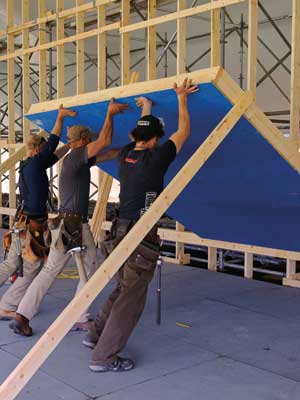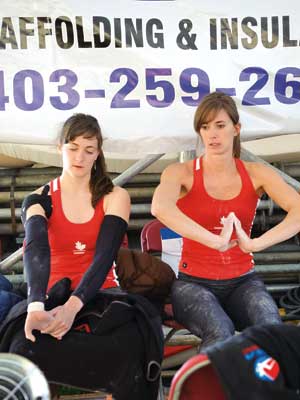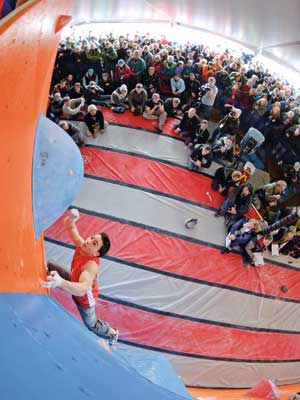The Story About Canada’s First Climbing World Cup
Dung Nguyen leaned forward in his seat and finished a sentence with "...and then we can take all this and apply for a World Cup. A World Cup would be next."

The following was written by Dave Dornian, an all-round climber whose efforts to establish competition climbing in Canada won him an A.O. Wheeler Award from the Alpine Club of Canada, back after Canada got its first World Cup.
2008
It was December and we were in a tiny cement-floored room in the back of Horizon Roc in Montreal, wrapping up the North American Continental Championships. We were fluorescent-lit and surrounded by bagged recyclables, negotiating for plug space on the single power bar.
Dung Nguyen leaned forward in his seat and finished a sentence with “…and then we can take all this and apply for a World Cup. A World Cup would be next.”
I remember his eyes gleaming behind his wire-rimmed glasses. He was still riding high from the medal ceremony. Andy Weldon, Director of Competition Climbing Canada – the CEC – at the time, glanced up from our spreadsheets, and around at the crumpled, coffee-ringed bills and receipts we were piling on our knees and the floor beside our metal chairs. He looked at me, gauging my reaction to this appalling expression of hubris. Then he squeezed his eyes shut, and pressed a thumb and forefinger to the lids. Right after that, a volunteer came through the curtain that served as our door, and collected the single folding table that was the only furniture in the room.
2009
Keith Ferguson, Executive Director of USA Climbing, whose previous employment was doing something similar for Pro Rodeo, where if you fall and can’t get up they shoot you, was organizer of the IFSC World Cup in Vail, Colorado, part of the high-profile Teva Games. Keith would look at all the Canadian climbers filling out the supplementary competitors list in Vail and he would pick up the phone and call me, skype me, send email, or point his finger at me if I was within physical range, and tell me repeatedly that Canada needed to host a World Cup of its own. European teams would have more reason to cross the Atlantic if there were two North American events to compete at instead of just one.
Keith understood that the CEC was impoverished and reluctant, so, one fine climbing-competition-day in Ibarra, Ecuador, he offered Dung a peek at USA Climbing’s powerful presentation and marketing materials, which pretty much sealed our fate. Think along the lines of candy, playgrounds, and sweet old men driving vans with the windows blacked out. Rubes collecting to buy snake oil at the travelling medicine show. Keith was the guy on the side of the road in that other bedtime story, the one offering Jack the handful of beans in exchange for the family donkey. We were, well and truly, on our way.
That summer I downloaded a simple form, filled it with speculations, and emailed it to the International Federation of Sport Climbing. The IFSC is the body that governs and regulates the World Cup calendar. You can find them on the Internet. This august group immediately emailed me back and asked for a 500 Euro deposit against their 3000 Euro calendar fee. At the time, as Treasurer for the CEC, I MAY have fronted this unbudgeted expense from money the Youth Team parents were giving us in the belief it was for their children’s travel to the World Youth Championships in Scotland. (Though, reading the records now, they say that maybe I didn’t) I even mentioned the competition application to the CEC Board during a conference call. I asked if they would like to have a World Cup. They said they thought that would be nice.
2010
Around the time of our marketing plan acquisition, Dung hiked up the hill from his little bouldering gym in Canmore to the Alpine Club of Canada offices and asked if they would like to be a sponsor at his event. One of many such sponsors. He promised. Big party, heh? High profile. Historical. At a venue within sight of their windows. And, um… maybe they would loan the event a little money? Just ’til the other sponsors began signing on? Nice. And, perhaps the ACC would offer to be the not-for-profit that would apply to the Province for a development grant? It would be easy-peasy. Terrific!
Actually, while Dung was still visiting the office that day, or at most a few seconds after he was out their door, the ACC staff immediately turned around and phoned me in Calgary to ask what he had been talking about. Trapped, I admitted that I had kinda-sorta already promised the IFSC that The Alpine Club of Canada would have its signatures on the World Cup contract, and held my breath. To the eternal credit of the Club and its paid staff, no one did the obvious thing and called the RCMP fraud division. Instead, they made a quiet suggestion: “That sounds interesting – why don’t you get together everything you have to date, and come in for a little chat?”
May, 2011
The wall plan was wrong. Dung had a schematic model on his laptop, all fancy flip this-and-that-away and zoom with your computer mouse. The design had been contracted from an international purveyor of such facilities, to Dung’s specifications.
The IFSC took a quick look and bounced our proposed layout as too small to mount enough boulder problems for an adequately impressive World Cup. Did it matter that we had already built our whole budget, grant applications, and ordered a sheltering tent and scaffolding to fit those smaller dimensions? Not a bit. Those were the rules. We ordered and paid for a redesign, sought and obtained permission to set a couple of the Qualifier problems on the warm up wall on the backside of the scaffolding if we needed to, and plunged further down the slope of deficit.

The new rules for Bouldering World Cups also stated that if there were more than 40 athletes registered in a category, two separate Qualifying Rounds needed to be held simultaneously, on different sets of problems.
Calculating that if this happened, Friday the 27th would need 36 hours, lights, and more routesetters than there were in the country, I switched my prayers from asking God for as many teams as possible to register (the rules also required that the event have spaces for a hundred entries), to hoping that a few would find the long and arduous trip to Kanukistan too much for their team’s budgets and refined sensibilities.
I contemplated delaying the invitation letters requested by the Russians for their travel visas. Shortly thereafter, Keith and the Americans began telephoning to request extra-quota consideration.

It rained the whole week of setup, gouts of water pouring in all directions as our expensive rented tent was hoisted over Canmore’s Millennium Park, and then of course, it snowed the night before – and all day during – Qualifiers. With dates like 26 and 27 May committed to an international calendar published a year in advance, and an event scheduled at an outdoor venue in a town park with no services, what else could we expect? Canmore is, after all, part of Canada – foreign misgivings and assumptions demanded arctic conditions. As we handed out umbrellas to our guests, and took them shopping for rubber boots at the consignment store downtown, IFSC officials and the British broadcast producer kept asking about the chance of bears or wolves crossing the field in front of the wall.
The Canadian Open Bouldering Team for 2011 was selected following the Tour de Bloc National Championships. More than 500 emails were exchanged back and forth with the CEC selection committee before the roster was finalized. Anyone with chalk under their nails wanted a piece of the action, and I believe that in the end we got the best of what the best in the country had to offer.

Not just the strongest climbing athletes, either, but also the cream of the entire community. Lev Pinter and Derek Galloway served on the local construction crew that scratch built the re-designed wall at the last moment. Seven of the country’s premier routesetters convened to take a course from international route setter Jacky Godoffe. They hung out for a week, and suffered in the cold, setting our problems as their practical exam. Walson Tai and the Flashed crew pulled an all-nighter to re-cut foam and re-sew mat covers to match the changes we’d not told them about the wall construction. Laurie Weldon briefed eight impeccable judges to backstop the IFSC officials.
Luigi Montilla, proprietor of the Tour de Bloc series, crossed the country on his own dime to shadow the proceedings (we forced him into servitude under Wim, the Jury President, entering real-time results on a laptop with frozen fingers from a cramped cockpit under the camera boom). John Haigh, a climbing partner who had never done me any wrong, assigned, and then re-assigned, and then re-re-assigned, a seemingly bottomless pool of more than 70 volunteers. Toby Harper, Programs Director for the ACC, abandoned his post as fiscal policeman temporarily to bring in 15,000 Moosehead. Then he went out again and purchased a truckload of OSB to lay walkways over the swamp developing under spectators’ feet. Everyone did their damnedest to coddle, transport, feed, dry, and warm-up the visiting competitors and their demanding coaches. Nancy Hanson dunned distributors for a fundraising auction. Will Gadd walked over to give colour commentary.
We sold more than a thousand tickets and who knows how many just walked in without paying. When Sean McColl topped problem number three during the finals, noise from the crowd was so loud it fed back through the mics and gorched our PA. As the sound washed over us, Luigi showed me a text from Toronto saying the webcast had overloaded the ifsc.tv servers – logins to our broadcast had exceeded its capacity and no more viewers could sign on. Mike the broadcast producer later told us that, at its peak, there were 300+ typing on the chat lines alone.

11:30 p.m. 27 May 2011
Coming off the elevator onto the third floor of the Ramada Inn later Saturday night, you could feel the thump of Cary Chang’s decks through the carpets. Just outside the doors to the party room, we had to walk below second place finisher Klemen Becan, being interviewed by media back in Slovenia on his cell phone.
He was stemmed across the hallway, up against the ceiling, to allow partiers returning from the bathroom to pass back and forth beneath.

I believe that the hosting of our first IFSC World Cup established a landmark for sport climbing in Canada. It brought together national and international sports organizations, involved the media, and joined climbing businesses. Everyone who didn’t volunteer sent it invoices.
The CEC and The Alpine Club showed off the best athletes in the world, and some of them were our own. The organizing committee navigated politics, finessed logistics, suffered cost overruns, endured hideous weather and in the end made cause for huge celebration. We learned some things, and now, like a wired boulder problem, we know we can do it any time we want. Years in the dreaming and making, the Canmore Bouldering World Cup was our Everest. It succeeded just by existing. A quarter century from now, expect to be watching the CBC movie.



